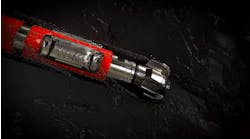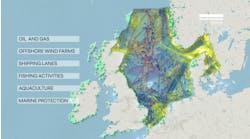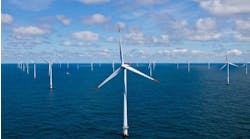New rules and standards were issued for the US offshore oil and gas industry in early March, as the Bureau of Safety and Environmental Enforcement (BSEE) released the Safety and Environmental Management Systems (SEMS) II final rule, and the American Petroleum Institute published two new standards for well design and drilling operations.
According to the BSEE, the SEMS II final rule "provides greater protection by supplementing operators' SEMS programs with greater employee participation, empowering field level personnel with safety management decisions, and strengthening oversight by requiring audits to be conducted by accredited third-parties."
This is an adjunct to the Workplace Safety Rule that became effective Nov. 15, 2010, which required operators to implement a SEMS program by Nov. 15, 2011, and to submit a first complete SEMS audit to BSEE by Nov. 15, 2013. The SEMS II Rule becomes effective on June 4, 2013. Operators have until June 4, 2014, to comply with the provisions of the SEMS II Rule, except for the auditing requirements. All SEMS audits must be in compliance with the SEMS II Rule by June 4, 2015.
This comes on the heels of BSEE's Dec. 20, 2012, Draft Safety Culture Policy Statement that outlines the administration's approach to establishing a "common definition" for all offshore workers and to inform operators of BSEE's safety expectations. Elements of a final Safety Culture Policy Statement are under consideration.
The SEMS II final rule expands, revises, and adds several new requirements to the existing 30 CFR part 250, subpart S, regulations for SEMS.
The additional safety requirements contained in this final rule that were not covered in previous regulations include:
- Developing and implementing a stop work authority that creates procedures and authorizes any and all offshore industry personnel who witness an imminent risk or dangerous activity to stop work.
- Developing and implementing an ultimate work authority that requires offshore industry operators to clearly define who has the ultimate work authority on a facility for operational safety and decision-making at any given time.
- Requiring an employee participation plan that provides an environment that promotes participation by offshore industry employees as well as their management to eliminate or mitigate safety hazards.
- Establishing guidelines for reporting unsafe working conditions that enable offshore industry personnel to report possible violations of safety, environmental regulations requirements, and threats of danger directly to BSEE.
- Establishing additional requirements for conducting a job safety analysis.
- Requiring that the team lead for an audit be independent and represent an accredited audit service provider.
It also makes mandatory elements of the American Petroleum Institute's (API) Recommended Practice 75 (RP 75).
Meanwhile, the API has published two new industry standards for well design and drilling operations.
One of these is RP 96, "Deepwater Well Design and Construction." It provides a reference for offshore well design, drilling, and completion operations in deepwater, and covers the range of considerations to include when planning and executing deepwater drilling.
This document does the following:
- Identifies the appropriate barrier and load case considerations to maintain well control during deepwater well operations (drilling, suspension, completion, production, and abandonment).
- Supplements barrier documentation in API 65-2 with a more detailed description of barriers and discussion of the philosophy, number, type, testing, and management required to maintain well control. This document also supplements the barrier documentation in API 90 with regard to annular pressure buildup. Abandonment barrier requirements are described for use when designing the well.
- Discusses load assumptions, resistance assumptions, and methodologies commonly used to achieve well designs with high reliability. The load case discussion includes less obvious events that can arise when unexpected circumstances are combined.
- Describes the risk assessment and mitigation practices commonly implemented during deepwater casing and equipment installation operations.
The other standard is Technical Report 1PER15K-1, "Protocol for Verification and Validation of High-Pressure High-Temperature Equipment." This publication gives a process to evaluate equipment for use in HP/HT environments offshore and onshore.
The report focuses on an evaluation process for HP/HT equipment in the petroleum and natural gas industries and includes design verification analysis, design validation, material selection considerations, and manufacturing process controls "necessary to ensure the equipment is fit-for-service in the applicable HP/HT environment."
This follows the November 2012 publication of API Standard 53, "Blowout Prevention Equipment Systems for Drilling Wells."
"We are the global leaders on setting the industry's standards, which are developed in accordance with ANSI-approved procedures in a rigorous and open review process," said David Miller, API director of Standards. "Every one of our standards is built on expert input from industry and the regulatory agencies."
Ecopetrol increases GoM presence with lease sale
Ecopetrol S.A. reports that its US affiliate has placed the most competitive bids for six blocks in the recent Central Planning Area Lease Sale 227 held in New Orleans, as disclosed by the Bureau of Ocean Energy Management (BOEM).
In this lease sale, Ecopetrol America Inc. partnered with Murphy Exploration and Production in two blocks; with Anadarko US Offshore Corp., MCX Gulf of Mexico LLC and JX Nippon Oil Exploration (U.S.A) Ltd. in two blocks; and in two blocks Ecopetrol America has 100% interest.
The official awarding of the blocks will be conducted by BOEM in the coming months after the checking of bids and ascertaining that the companies fulfill the conditions required for the round.
The economic bids placed by Ecopetrol America and its partners in the six blocks add up to approximately $15.5 million, with Ecopetrol America's share consisting of approximately $6.2 million.
These blocks allow deepwater hydrocarbon exploration in water depths of over 221 m (725 ft) for a five to seven-year period. The new blocks are added to the 47 obtained on the GoM in previous lease sales. With these six blocks, Ecopetrol America Inc. could increase its participation in this prolific hydrocarbon basin to 136 blocks.
The results obtained strengthen Ecopetrol's position in the Gulf of Mexico, which it considers a focus area in its internationalization process.
Chevron discovers Lower Tertiary oil at Coronado prospect
Chevron Corp. has reported an oil discovery at the Coronado prospect in the deepwater US Gulf of Mexico. Walker Ridge block 98 Well No. 1 encountered more than 400 ft (122 m) of net pay. The well is located approximately 190 mi (308 km) off the Louisiana coast in 6,127 ft (1,868 m) of water and was drilled to a depth of 31,866 ft (9,713 m).
"The Coronado discovery continues our string of exploration successes in the Lower Tertiary trend, where Chevron is advancing multiple projects," said Gary Luquette, president, Chevron North America Exploration and Production Co. "It also highlights the importance of the deepwater Gulf of Mexico as a source of domestic energy for the United States."
Offshore Articles Archives
View Oil and Gas Articles on PennEnergy.com




